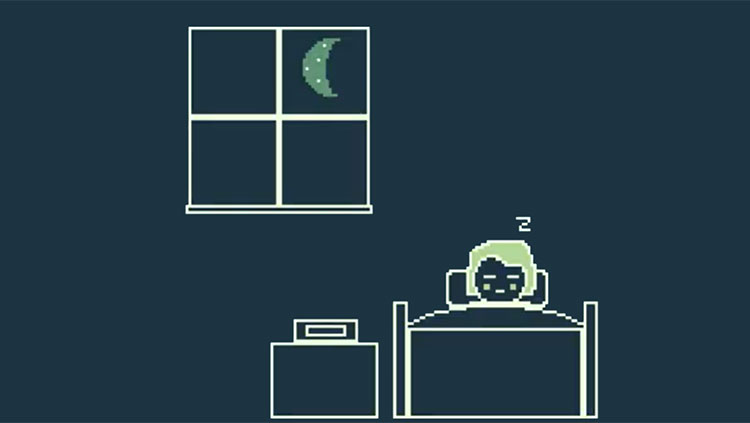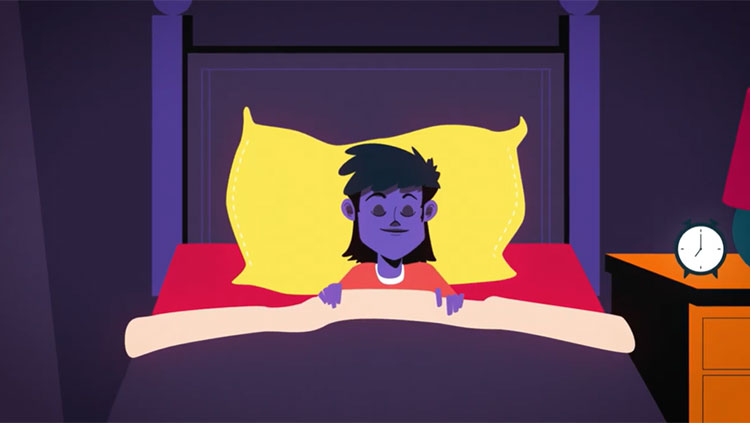Whether you remember it or not, you dream every time you fall asleep. Dreams arise from random neurons firing in your sleep, yet scientists aren’t sure why this happens. Dreaming may help you prepare for potential threats, sort through memories, or live out suppressed emotions.
This video is from the 2020 Brain Awareness Video Contest.
Created by Shruti Kedharnath
CONTENT PROVIDED BY
BrainFacts/SfN
Transcript
What do you dream about?
Maybe you dream about wielding a wand and defeating evil, or finally getting into the college of your dreams. Maybe you dream you vacationed to your favorite country or met your favorite celebrity.
But what exactly is a dream, and why do we dream?
Scientists have concluded that everyone dreams when they are asleep. Some people remember these dreams, while others do not.
Now, there are two stages of sleep. Slow wave sleep and REM (random eye movement) sleep. Dreaming mostly occurs in the REM phase of sleep. This is where we “dream” when random neurons fire.
Scientists usually study sleep by what people can remember upon awakening, but recent advances in technology have allowed more objective studying of dreams. In fact, one lab was able to create a “dream map” using MRI patterns and cross-referencing once the person woke up. However, the reason for our dreams has been long debated by professionals in the field.
So why exactly do we dream?
There are various theories. The first category of these theories are ones are grounded in neuroscience in combination with psychology. In 1977, J. Allan Hobson and Robert McCarley proposed the activation-synthesis model of dreaming. They discovered that many circuits in the brain are activated during REM sleep. Many of these circuits were embedded within the limbic system, which include the amygdala, the almond-shaped emotion center, and the hippocampus, a seahorse shaped memory center of the brain. These brain impulses, they suggested, are synthesized and analyzed to find meaning. This model suggests we don’t actually “dream,” but that once we awake, we pull all the random neural firings together to form a coherent narrative we can make sense of.
The next theory, proposed in 1968 by Dr. Richard Atkinson and Dr. Richard Shiffrin is the “information-processing theory,” which states that a significant reason for sleep is to store and organize the experiences and thoughts from the day.
Many scientists agree that dreaming is a side effect of the neural impulses that are fired in the processing of the day’s information input. This is supported by research that shows that during REM sleep, the frontal lobe sees increased activity of low frequency theta waves, which is similar to the activity during memory storage and consolidation. Essentially, memories in the process of being deleted or taken to long-term storage are displayed as the images you see in the dream.
Meanwhile, the “continuity hypothesis” proposed by Dr. Calvin hall in 1971 shows that dreams replay certain life experiences, especially ones with emotional connotations.
This segues into another theory, first discussed in the 1960s called the “emotion regulation theory” which suggests that dreams help us cope with trauma and handle our emotions. Scientists have found that the amygdala, our brain’s emotional center, and the hippocampus, our brain’s memory center, are active during REM sleep, implicating dreaming with emotions and memory. Not to mention, research shows that stress neurotransmitters are at lower levels during sleep, which helps the brain “heal emotionally.”
The second category of theories are ones grounded more in the psychology of why we would dream. Scientist Sigmund Freud expressed ideas that aligned with the “dream rebound theory.” This theory states that dreams are the result of the human personality’s repressed emotions and desires. In his book The Interpretations of Dreams he states that dreams are “disguised fulfillments of repressed wishes.”
Although most of his ideas have been disproven, some experts still believe that suppressed desires can show up in dreams.
Interestingly, the “threat simulation theory” proposed in 2000 by Dr. Antti Revonsuo suggests that your brain prepares you for possibly life-threatening experiences by activating fight or flight instincts during your dreams. This theory suggests explanations for embarrassing or awkward scenarios as well as situations like dangling off a cliff or the feeling of falling. It suggests we are being “trained” by our brain to handle possibly stressful experiences.
As more research is put into dreaming, we uncover more and more hidden mysteries about dreams and why we dream. Overall, no matter which theory you believe, it is important to understand how critical a good night’s sleep is to deal with daily emotions and memory consolidation
Also In Sleep
Trending
Popular articles on BrainFacts.org
















